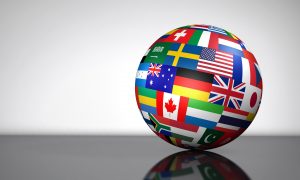Foreign companies that sell to customers in the United States often find that the U.S. system of taxing the sale of goods and services is vastly different from the taxing system of their country. This is especially the situation if the foreign seller is from a country that imposes Value Added Tax (VAT).
Although there are some similarities between the U.S. sales tax and a VAT system, there are many differences. For foreign sellers that are just beginning to sell into the U.S. market, there is much to know. In addition to understanding how U.S. sales taxes are applied, foreign sellers need to be aware of their responsibilities as “tax collection agents”, that a uniform tax rate does not apply across the entire the United States, or that sellers can be subject to severe penalties for not fulfilling their responsibilities.
Yes, there is a lot to know! So in this post, I’ll provide an overview of a few key concepts of the U.S. sales tax system and highlight how the sales tax differs from a VAT. I’ll also provide a chart with some of the key VAT versus sales tax differences.
Revisiting Nexus
I’ve previously explained that the U.S. sales tax system allows each individual State to impose its own rules about what is and what is not taxable and what sales tax rate should apply to a sale transaction.
Previously, I also explained the concept of “nexus”, which is the “connection” that an out-of-state (or foreign) company or seller must have to a specific State before the State can tax or impose other duties on the company or seller. Having a sufficient “nexus” gives a State the authority to require a seller (including a foreign seller) to collect its sales tax. I also pointed out that having inventory or employing the services of an independent agent in a state, are activities that just about every state would consider to be a sufficient “nexus”. Finally, I have also previously highlighted that even though these same activities might not create a U.S. Permanent Establishment (PE) because States are not bound by bi-lateral treaties that the U.S. Government enters into, a foreign seller can still be subject to the State’s tax and requirements even if the seller is not subject to federal taxation.
Key Comparisons Between Sales Tax and VAT
Once a foreign company/seller is found to have nexus to a specific state, the company/seller must comply with the requirements of that state. Therefore, the first thing to highlight in today’s post is that sales tax is not a tax on the seller. When a seller has a sufficient nexus to a state, the seller has a responsibility to collect the tax due on the sale transaction if the purchaser is the final consumer of the product or service. A general rule regarding whether sales tax is due on a transaction is that sales of tangible personal property (TPP) are always taxable unless a specific state exemption applies. (I’ll touch on sales tax exemptions in a minute.) But TPP is more than just goods that can be held or seen. TPP subject to sales tax can include digital goods, such as e-books and digital downloads, or software accessed via the cloud. As a matter of fact, one of the most controversial areas of sales taxation in the U.S. deals with whether and how digital, cloud based, and SaaS products are taxed. But getting back to the basics, one more general rule is that services are generally not subject to tax. A service is only taxed if a State law specifically says that the specific service is taxable.
Therefore, one way that a VAT compares to a sales tax is that a VAT is generally imposed at every stage of production on all “business inputs”. For instance, VAT is charged when raw materials are sold to a manufacturer, again when the manufacturer sells his finished product to a distributor, again when the distributor sells the product to a retailer and once again, when the product is sold to the final consumer. Although to those not familiar with a VAT, it may appear that the tax is collected/paid in full multiple times, this isn’t the case. This is basically because VAT is charged on the gross profit or value added each time the product moves through the supply chain. What this means is that VAT is charged and collected in increments as the products and/or services move to the final consumer. However, sales tax is only charged and collected once – when the goods or taxable services are sold to the final consumer at the total final sale price.
Foreign sellers accustomed to all business inputs being taxed may wonder how it is that tax is not charged at each stage of production. Here is yet one more difference between the U.S. sales tax and VAT system. In general, many of the same business inputs that would be subject to VAT are often exempt from sales tax. This is because many business inputs such as raw materials, components that will integrated into another product, machinery & equipment used in the manufacturing process, and finished inventory purchased for resale, are generally exempt under the various State sales tax laws.
This means that a seller is not required to charge and collect sales tax upon the sale of an exempt business input as long as the purchaser provides a valid exemption or resale certificate. The rules on which exemption certificate must be obtained from a purchaser to excuse the seller from charging sales tax are complex. Some states, such as Massachusetts, may have a single form which can be used to claim a variety of different exemptions (click here to see Massachusetts Form ST-12, Exempt Use Certificate. Notice the many business input categories listed on the form.) Other states may have a different form for each type of business input (one form for inventory purchased for resale, a different form for machinery/equipment used in manufacturing, etc.) And some States accept a general Multi-juridictional form.
So, in conclusion, today I touched on just a couple of ways in which U.S. sales tax differs from VAT. Certainly there are more than just these, but we’ll leave those for another post! In addition to the brief overview above, I’ve also created the following chart which summarizes these main points.
|
Value Added Tax (VAT)
|
Sales Tax
|
|
VAT is an indirect tax charged/collected at each stage of production.
|
Sales tax charged/collected only from the final consumer.
|
|
VAT is generally due on all “business inputs” such as raw materials, machinery & equipment, supplies, business services, etc.
|
Sales tax is often not due on “business inputs” because these inputs often qualify for an exemption from sales tax, (e.g., resale, manufacturing, etc.)
|
|
Because VAT is collected at each stage of production, the seller generally does not have a responsibility to verify whether the purchaser is another producer or distributor or how the goods or services purchased will be used.
|
The seller is responsible for collecting the sales tax from the purchaser unless the purchaser provides the seller with a valid certificate verifying that the purchase is for resale, or the goods or services purchased qualify for an exemption.
|
|
In general, all business inputs, which include business services, are subject to VAT.
|
In general, services are exempt from sales tax unless the state or local jurisdiction lists the specific service as being taxable.
|
|
VAT creates an incentive to collect the tax because the government only receives the tax on the gross margin of each transaction.
|
Sellers do not have a direct economic incentive to collect sales tax.
|
Sylvia’s Summation
The U.S. sales tax rules are complex even for U.S. based companies – and can be even more confusing for foreign sellers. And so, this is why I’ll be blogging about many different sales tax topics with a focus on foreign companies/sellers. If you’re a foreign seller or foreign company and have specific topics in mind, I encourage you to post your suggestions. Of course, questions and comments are always welcome!
Like this post? Click on the “SHARE” link to Share It on Social Media
If you would like to translate this post to a different language, click on the menu above to open Google Translate and select your language
Are you a foreign seller interested in a tax consultation? Submit a contact request or email Sylvia Dion at sylviadion@prietodiontax.com
This post was originally published on SalesTaxSuport* and is now available here at The State & Local Tax ‘Buzz’ Blog. This is one of several posts on U.S. Sales Tax for Foreign Sellers here at The State and Local Tax ‘Buzz’ Blog.
About the Author: Sylvia F. Dion, CPAis the Founder and Managing Partner of PrietoDion Consulting Partners LLC, a State & Local Tax (SALT) Consulting firm providing comprehensive tax services to U.S. and International businesses. Sylvia’s 25 years of multi-faceted tax experience includes holding leadership positions with some of the highest regarded international accounting firms and providing SALT services to companies around the world. From 2011 through 2019, Sylvia also served as a contributor to the SalesTaxSupport* blogs, where she blogged on Internet Sales Tax and Economic Nexus, U.S. Sales Tax for Foreign Sellers and Massachusetts Sales Tax. Sylvia is also a speaker and author whose articles have been published by Bloomberg BNA and in other leading professional tax journals and is the author of “Minding Massachusetts,” a quarterly column published by Tax Analysts’ State Tax Notes. Sylvia is also fluent in Spanish. For more about Sylvia visit the her firm website at www.prietodiontax.com or www.sylviadioncpa.com. You can follow Sylvia on twitter and on Google+ and can contact Sylvia via e-mail at sylviadion@prietodiontax.com
*SalesTaxSupport was formerly a sales tax resource website which closed on March 1, 2019. Many of Sylvia’s posts previously published on SalesTaxSupport have been republished here at The State and Local Tax ‘Buzz’ Blog.




